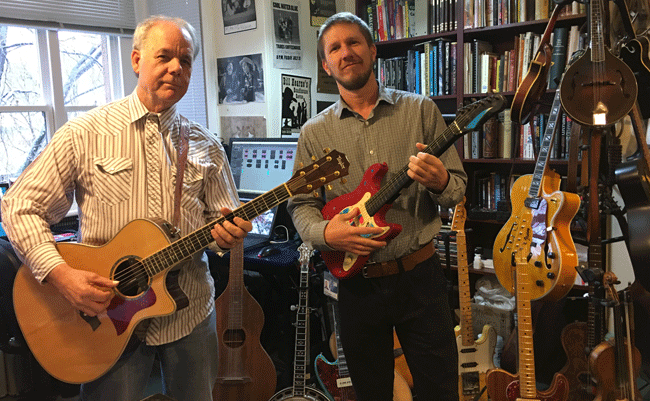Thursday 20 February 2020 10:45pm

Collaboration ... Music's Dr John Egenes (left) and ITS's Ryan Gollner.
One’s a musician and lecturer who’s mad about technology. The other’s an IT professional who also happens to be a musician and sound engineer.
Together they embody the spirit of collaboration between music academics and the University’s ITS department which has flowered as the University of Otago’s new $26 million Music, Theatre and Performing Arts facility in Dunedin comes to fruition.
Senior Lecturer in Contemporary Music and self-confessed computer geek Dr John Egenes is unashamedly enthusiastic about the ways technology can help deliver a world-class experience for students.
“We have these opportunities to change the way we teach, the way in which students learn and the ways in which you take that learning and interact with the rest of the world.
"We have these opportunities to change the way we teach, the way in which students learn and the ways in which you take that learning and interact with the rest of the world."
“Soon a student will probably be able to flick their phone with their thumb and throw something up onto the screen for the class to work with. And it’s not for the sake of it. It’s actually really efficient and allows participation from the students in ways they never have been able to do before.”
As John and his music colleagues explore the possibilities of future teaching, they’ve found allies in the ITS department.
Among them is University Team Leader AV Support Ryan Gollner, a musician himself who is also a studio producer/engineer.
“I was psyched from the very beginning,” Ryan says. “I wanted to be a part of it ... Having a production and music background I just can’t help but be enthusiastic to help out in all areas and that’s the way it’s been.”
These two are part of a broader team of Music and ITS staff who have helped guide aspects of the project in Union Street East, which will be operational for the 2020 academic year.
The development has involved constructing a new two-storey recording studio building while refurbishing the nearby University of Otago College of Education's Music Suite, Teaching Wing, Tower Block and part of the Education Resource Centre.
One of the key feature is interconnectedness, both within the facility and with the outside world, to allow real-time collaboration.
An advanced audio networking system called Dante will enable all the different audio and visual components to link seamlessly.
“The recording studio is going to be seriously beautiful,” John says. “And next to that is the music suite. Then there’s the teaching wing. They’ll all be hooked together so I could easily envisage us having a recording session in the studio and then being in the lab with students dealing with it in real time and maybe even recording on their own computers there, each one doing their own version of the recording.
"We’re effectively going invisibly behind the scenes and saying ‘Ok how do you teach what’s going on in here?’ So we’re adding cameras, we’re adding the ability to monitor, we’re adding the ability to send that feed out to share it with the rest of the world."
“Universities are oftentimes siloed off, with each department doing their own thing, unaware of what people in other departments around them are doing. But we don’t live in that world any more. The real world now is a connected world that reaches all around you in real time.”
This push for interconnection informed the audio-visual design provided by Rebecca Ottley and Ryan Walker, which had to meet the standards of a world-class facility while also enforcing the needs of teaching, explains Ryan.
“We’re effectively going invisibly behind the scenes and saying ‘Ok how do you teach what’s going on in here?’ So we’re adding cameras, we’re adding the ability to monitor, we’re adding the ability to send that feed out to share it with the rest of the world.”
As well as catering for the needs and expectations of today’s students, the environment has the flexibility and built-in capability to take advantage of technology yet to be invented.
University Head of IT Infrastructure Daryl Clarkson explains: “It’s a really interesting project because there’s a large variety of different technologies involved. We’ve done our best to future proof it with lots of capacity for future expansion.”
In the meantime the ideas keep bubbling away.
“With John and University Music Technician Stephen Stedman, we’re sharing ways to create collaborative pods in teaching spaces,” says Ryan.
“That’s not necessarily music but we’re like, ‘That’s really cool.’ It’s been this really creative team effort.”
